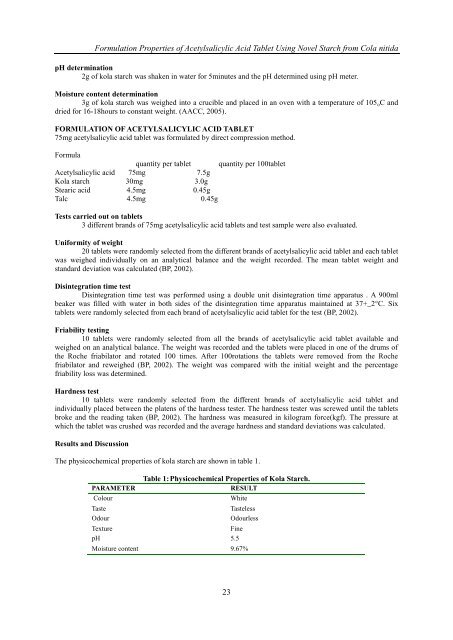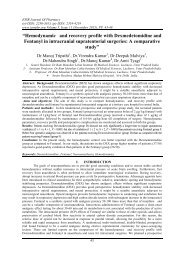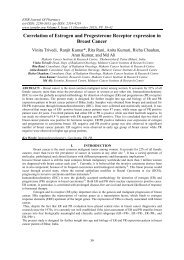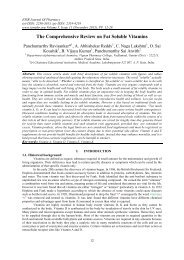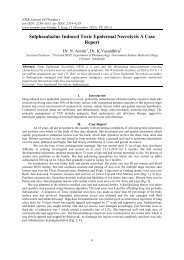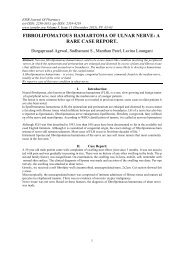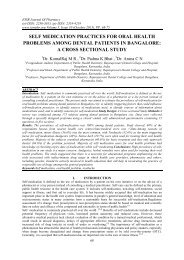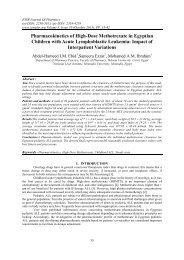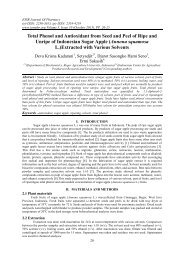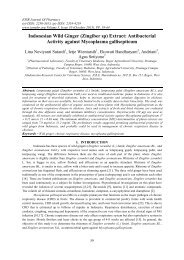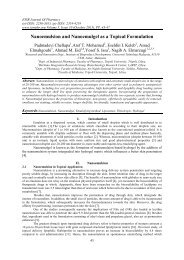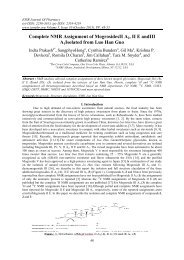Formulation Properties of Acetylsalicylic Acid Tablet Using Novel Starch from Cola nitida
Create successful ePaper yourself
Turn your PDF publications into a flip-book with our unique Google optimized e-Paper software.
<strong>Formulation</strong> <strong>Properties</strong> <strong>of</strong> <strong>Acetylsalicylic</strong> <strong>Acid</strong> <strong>Tablet</strong> <strong>Using</strong> <strong>Novel</strong> <strong>Starch</strong> <strong>from</strong> <strong>Cola</strong> <strong>nitida</strong><br />
pH determination<br />
2g <strong>of</strong> kola starch was shaken in water for 5minutes and the pH determined using pH meter.<br />
Moisture content determination<br />
3g <strong>of</strong> kola starch was weighed into a crucible and placed in an oven with a temperature <strong>of</strong> 105 o C and<br />
dried for 16-18hours to constant weight. (AACC, 2005).<br />
FORMULATION OF ACETYLSALICYLIC ACID TABLET<br />
75mg acetylsalicylic acid tablet was formulated by direct compression method.<br />
Formula<br />
quantity per tablet quantity per 100tablet<br />
<strong>Acetylsalicylic</strong> acid 75mg 7.5g<br />
Kola starch 30mg 3.0g<br />
Stearic acid 4.5mg 0.45g<br />
Talc 4.5mg 0.45g<br />
Tests carried out on tablets<br />
3 different brands <strong>of</strong> 75mg acetylsalicylic acid tablets and test sample were also evaluated.<br />
Uniformity <strong>of</strong> weight<br />
20 tablets were randomly selected <strong>from</strong> the different brands <strong>of</strong> acetylsalicylic acid tablet and each tablet<br />
was weighed individually on an analytical balance and the weight recorded. The mean tablet weight and<br />
standard deviation was calculated (BP, 2002).<br />
Disintegration time test<br />
Disintegration time test was performed using a double unit disintegration time apparatus . A 900ml<br />
beaker was filled with water in both sides <strong>of</strong> the disintegration time apparatus maintained at 37+_2°C. Six<br />
tablets were randomly selected <strong>from</strong> each brand <strong>of</strong> acetylsalicylic acid tablet for the test (BP, 2002).<br />
Friability testing<br />
10 tablets were randomly selected <strong>from</strong> all the brands <strong>of</strong> acetylsalicylic acid tablet available and<br />
weighed on an analytical balance. The weight was recorded and the tablets were placed in one <strong>of</strong> the drums <strong>of</strong><br />
the Roche friabilator and rotated 100 times. After 100rotations the tablets were removed <strong>from</strong> the Roche<br />
friabilator and reweighed (BP, 2002). The weight was compared with the initial weight and the percentage<br />
friability loss was determined.<br />
Hardness test<br />
10 tablets were randomly selected <strong>from</strong> the different brands <strong>of</strong> acetylsalicylic acid tablet and<br />
individually placed between the platens <strong>of</strong> the hardness tester. The hardness tester was screwed until the tablets<br />
broke and the reading taken (BP, 2002). The hardness was measured in kilogram force(kgf). The pressure at<br />
which the tablet was crushed was recorded and the average hardness and standard deviations was calculated.<br />
Results and Discussion<br />
The physicochemical properties <strong>of</strong> kola starch are shown in table 1.<br />
PARAMETER<br />
Colour<br />
Taste<br />
Odour<br />
Table 1: Physicochemical <strong>Properties</strong> <strong>of</strong> Kola <strong>Starch</strong>.<br />
RESULT<br />
White<br />
Texture<br />
Fine<br />
pH 5.5<br />
Tasteless<br />
Odourless<br />
Moisture content 9.67%<br />
23


